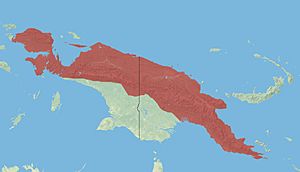New Guinean quoll facts for kids
Quick facts for kids New Guinean quoll |
|
|---|---|
| Conservation status | |
| Scientific classification | |
| Genus: |
Dasyurus
|
| Species: |
albopunctatus
|
 |
|
| New Guinean quoll range | |
The New Guinean quoll (Dasyurus albopunctatus) is a fascinating marsupial mammal that lives in New Guinea. It's also known as the New Guinea quoll or New Guinea native cat. This animal is a carnivore, meaning it eats meat. It's the second-largest marsupial carnivore still living in New Guinea today.
Contents
What's in a Name?
In the Kalam language of Papua New Guinea, this animal is called suatg.
Meet the Family: Quoll Taxonomy
The New Guinean quoll belongs to a family of meat-eating marsupials called Dasyuridae. This family includes other cool animals like different types of quolls, the extinct thylacine (also known as the Tasmanian tiger), and the Tasmanian devil. It also includes many smaller carnivores.
There are six types of quolls alive today. Four of them live only in Australia. The other two, including the New Guinean quoll and the bronze quoll, are found only in New Guinea. Scientists think the New Guinean quoll and the bronze quoll are most closely related to the western quoll from Australia.
How to Spot a New Guinean Quoll
The New Guinean quoll is a small animal. It usually weighs just over 1 pound (0.45 kg). Its body is brown with white spots on its back. These spots do not go onto its tail, which has only a little bit of hair.
This quoll looks a bit like a cat or an opossum. That's why people sometimes call them "native cats" or "marsupial cats." Their feet have special pads with ridges. These ridges probably help them grip things, which is useful for climbing trees.
New Guinean quolls live in the forests all over New Guinea. You can find them at different heights, from sea level up to 11,000 feet (3300 meters). However, they usually live closer to 3,000 feet (900 meters) high. Most of these quolls seem to live in the highland areas of New Guinea.
Daily Life: Behavior and Diet
Quolls are not picky eaters! They hunt and eat many different kinds of prey. This includes birds, rats, other small marsupials, small reptiles, and insects. Sometimes, they even eat animals that are bigger than themselves!
These quolls are very good climbers. They spend a lot of time in trees. But they also come down to the forest floor to hunt and explore. They are nocturnal, meaning they are most active at night. During the day, they like to rest and bask in the sun.
When it's time to sleep or hide, they make their nests in rocky banks, hollow logs, or small caves. In zoos, some quolls have lived for up to three years. We don't know exactly how long they live in the wild.
Challenges for the Quoll: Threats
The number of New Guinean quolls is thought to be going down. This is mainly because humans are moving into their habitat. When people build homes or farms, the quolls lose their natural hiding places and hunting grounds. Sometimes, people might also harm quolls because quolls are known to scavenge for food.
Another big problem for quolls comes from animals that are not native to New Guinea. These include dogs and cats, which can hunt quolls or compete with them for food.
A different kind of threat comes from the cane toad (Rhinella marina). These toads were brought to New Guinea by humans. Quolls have not lived near toads for millions of years. This means their bodies are not good at fighting off the poisons that cane toads produce. When a quoll tries to eat a cane toad, it can get very sick or even die. While smaller animals sometimes learn not to eat these toads, there isn't much proof that quolls learn this lesson.
Images for kids
See also
 In Spanish: Satanelo de Nueva Guinea para niños
In Spanish: Satanelo de Nueva Guinea para niños



